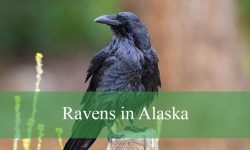The state of Colorado offers a remarkable range of moths, including tiny bark-mimicking species and large silk moths with dazzling wing patterns. These insects play an important role in the state’s ecosystems as pollinators, prey for birds and bats, and indicators of environmental health.
The state’s unique geography, with its mix of mountains, plains, and desert landscapes, provides habitats for a wide variety of moths. From alpine meadows in the Rockies to grasslands in the east, each region hosts moth species adapted to its specific environment. This makes Colorado a rewarding destination for nature enthusiasts and lepidopterists alike.
In this guide, we’ll explore 25 types of moths found in Colorado, complete with pictures and identification details. You’ll learn how to recognize them, where to find them, and the best times of year to observe their incredible diversity in the wild.
Different Types of Moths Found in Colorado
Hummingbird Clearwing Moth (Hemaris thysbe)
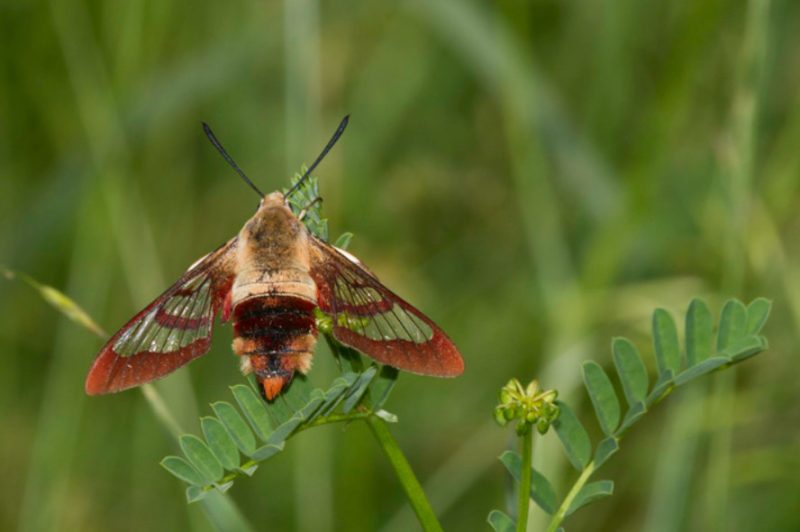
The Hummingbird Clearwing Moth is one of the most fascinating moths in Colorado, often mistaken for a small hummingbird because of its rapid wingbeats and hovering flight. Its wings are mostly transparent, edged with reddish-brown scales, and its body is olive green with a reddish abdomen. This moth is medium-sized, with a wingspan of about 1.5 to 2 inches.
In flight, the Hummingbird Clearwing darts from flower to flower, using its long proboscis to sip nectar, much like a hummingbird. People often notice its buzzing sound and fast movements, making it one of the most recognizable day-flying moths in the region. Its primary food plants for caterpillars include honeysuckle, viburnum, and hawthorn.
In Colorado, it can be found in gardens, meadows, and forest edges, particularly during the summer months. Its activity peaks in daylight, which makes it much easier to observe compared to most nocturnal moths.
White-lined Sphinx Moth (Hyles lineata)
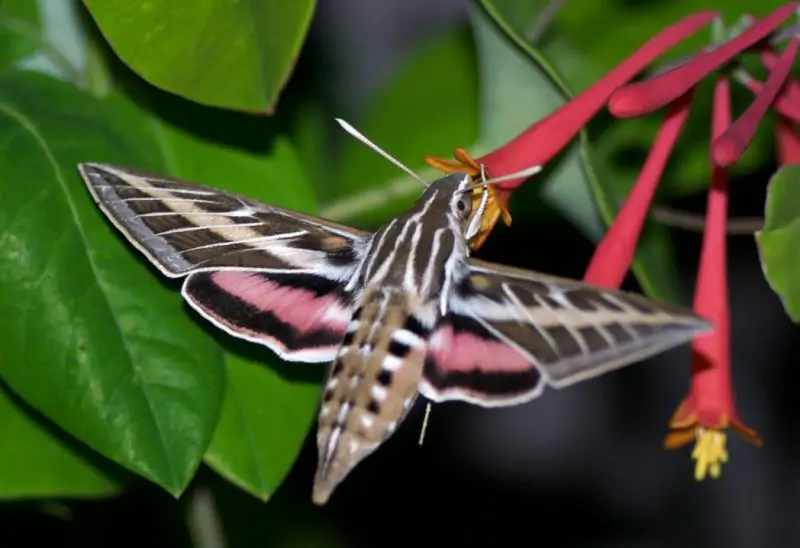
The White-lined Sphinx Moth is among the most common and widespread large moths in Colorado. It is notable for its striking forewings, which are dark brown with bold white stripes running diagonally across them. The hindwings are pink with black borders, creating a colorful display when the moth is in flight. Adults have a wingspan of 2 to 3 inches.
This moth is also known as a “hawkmoth” because of its strong, fast flight. It feeds at dusk and dawn, often hovering over flowers such as petunias, phlox, and honeysuckle. Its long tongue allows it to feed on tubular flowers, acting as a pollinator in the process.
In Colorado, the White-lined Sphinx is very common during the summer, especially in years with abundant rainfall. They can be found in gardens, open fields, and foothills, and are one of the moths most frequently seen by residents.
Five-spotted Hawkmoth (Manduca quinquemaculata)
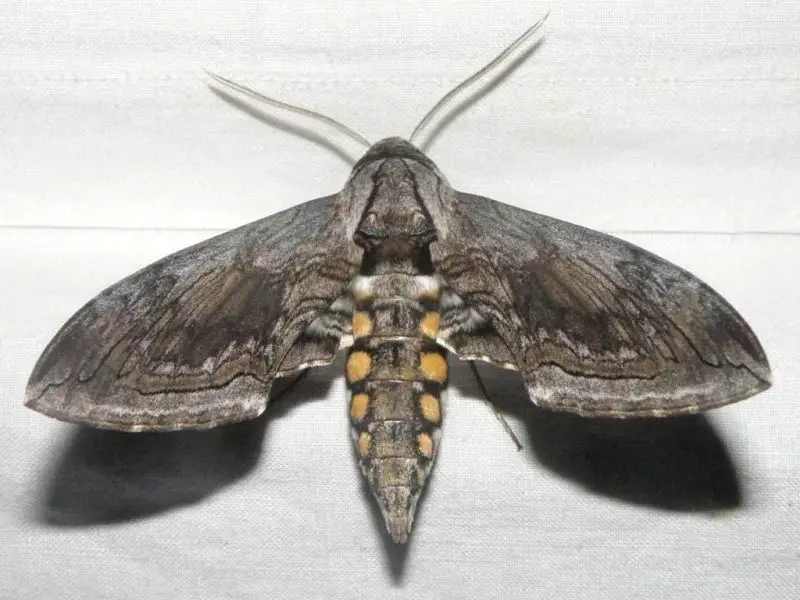
The Five-spotted Hawkmoth is a large, powerful flier that is often encountered in Colorado gardens where tomato plants grow. Adults are grayish-brown with intricate wing patterns that provide camouflage against bark and leaves. Their name comes from the five pairs of yellow spots on their abdomen. Wingspans range from 4.5 to 5.5 inches, making them among the largest moths in the state.
The caterpillars of this species are known as tomato hornworms, notorious for feeding on tomatoes, peppers, and other members of the nightshade family. Despite being considered pests by gardeners, the adult moths are impressive nighttime pollinators.
In Colorado, these moths are commonly seen at dusk in agricultural areas, gardens, and open habitats. Their strong, hovering flight allows them to visit large flowers, and they are especially active during warm summer evenings.
Achemon Sphinx Moth (Eumorpha achemon)
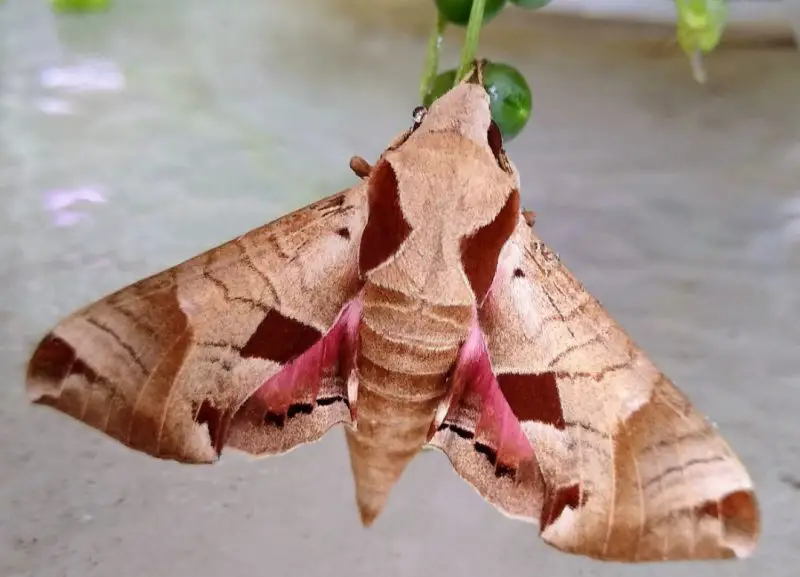
The Achemon Sphinx Moth is another large hawkmoth species found in Colorado. Its wings are patterned in shades of brown, gray, and pink, creating an attractive camouflage that helps it blend into tree bark. The hindwings show a flash of pink when opened, which can startle predators. Wingspans usually measure 3 to 4 inches.
Caterpillars of this species feed on grapevines, Virginia creeper, and related plants. They are large and green or brown, with a reduced horn on the rear end that distinguishes them from other sphinx moth larvae. Gardeners who grow grapes may sometimes notice these caterpillars.
In Colorado, adults are most active from late spring through summer. They are nocturnal and attracted to light, making them a frequent visitor to porch lamps and garden flowers at night.
Catalpa Sphinx (Ceratomia catalpae)
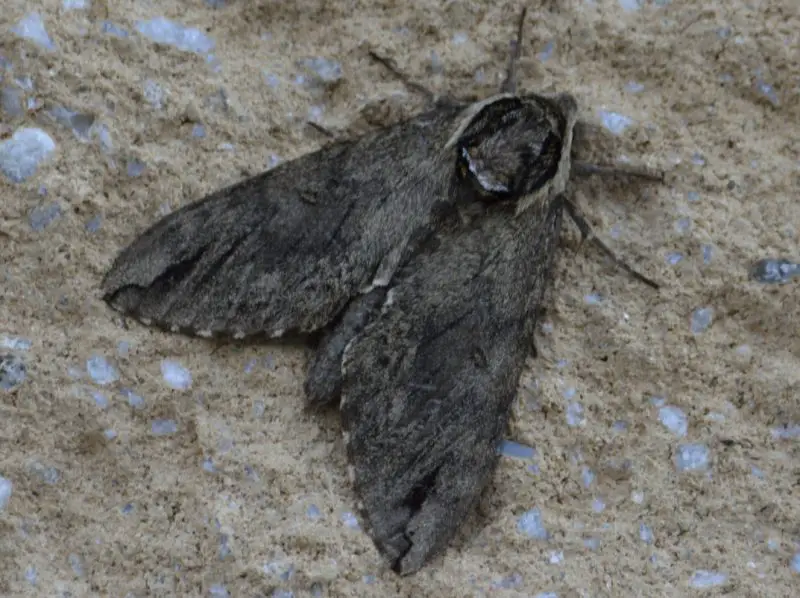
The Catalpa Sphinx Moth is known for its close relationship with catalpa trees, which serve as the sole host plant for its caterpillars. Adults are gray-brown with mottled wings and a wingspan of 2.5 to 3.5 inches. They have a streamlined body typical of hawkmoths and are well-camouflaged when resting on bark.
The caterpillars, often called “catalpa worms,” are black and yellow with striping patterns and are famous among anglers as excellent fishing bait. These caterpillars can appear in large numbers, defoliating catalpa trees, but the trees usually recover.
In Colorado, the Catalpa Sphinx is found wherever catalpa trees are planted, particularly in urban areas, parks, and yards. Adults are mainly active at night during summer and can be seen feeding on nectar from a variety of flowers.
Pandora Sphinx (Eumorpha pandorus)
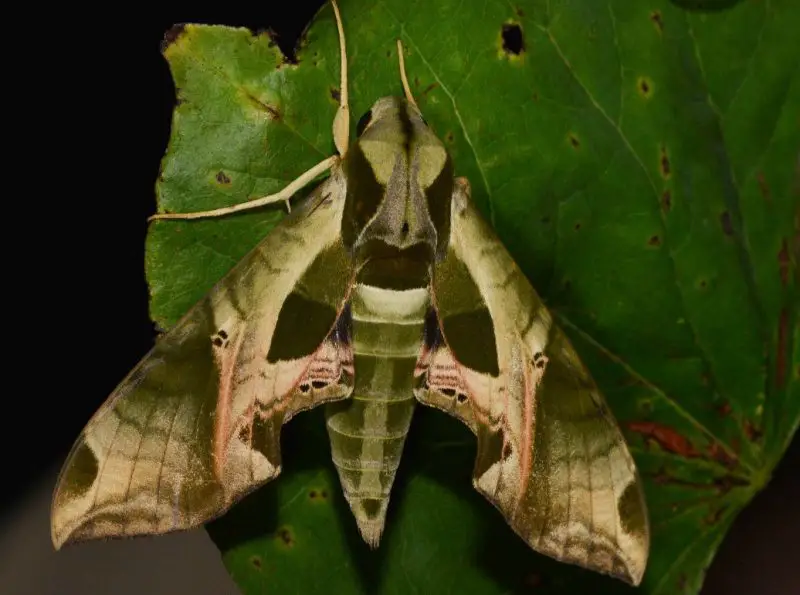
The Pandora Sphinx is a striking moth with olive-green wings marked with patches of brown and pale green. Its hindwings often show shades of pink and orange, which are revealed in flight. With a wingspan of 3.5 to 4.5 inches, it is one of the larger sphinx moths found in Colorado.
The caterpillars feed primarily on grapevines and Virginia creeper, similar to the Achemon Sphinx, but they are often larger and more colorful. They can vary in appearance, ranging from green to reddish-brown, and they usually have diagonal stripes along their sides.
In Colorado, the Pandora Sphinx can be found in gardens, vineyards, and woodlands where host plants grow. Adults are mostly nocturnal and are attracted to lights, although they can sometimes be seen at dusk feeding from deep-throated flowers.
Big Poplar Sphinx (Pachysphinx modesta)
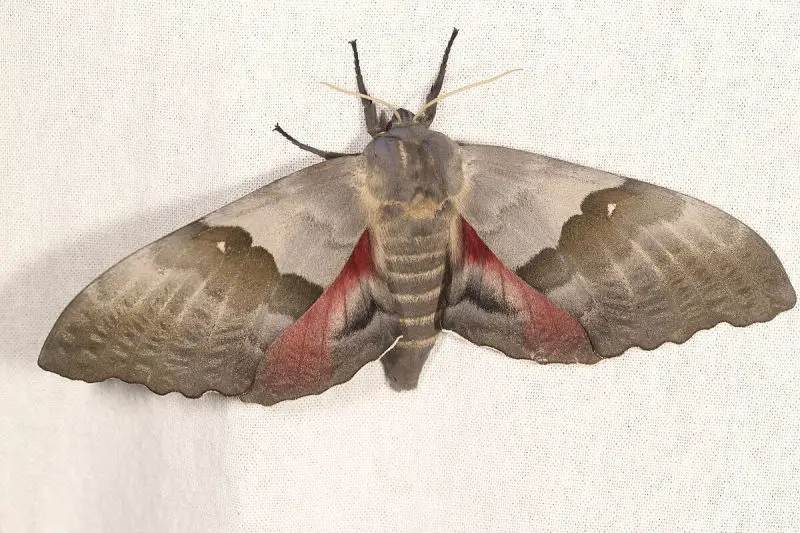
The Big Poplar Sphinx is one of the largest moths in Colorado, with a wingspan reaching up to 6 inches. Its forewings are mottled gray and brown, providing excellent camouflage against tree bark. The hindwings are decorated with shades of red, blue, and black, which are usually hidden when the moth is at rest.
The caterpillars feed on poplar, cottonwood, and willow trees, which are abundant across Colorado. These larvae are large, green, and have a pointed horn on their tail end, a typical feature of many sphinx caterpillars.
This species is often found near riparian areas, cottonwood groves, and mixed forests. Adults are nocturnal and rarely seen during the day, but they occasionally come to porch lights at night, startling observers with their large size.
Rustic Sphinx (Manduca rustica)
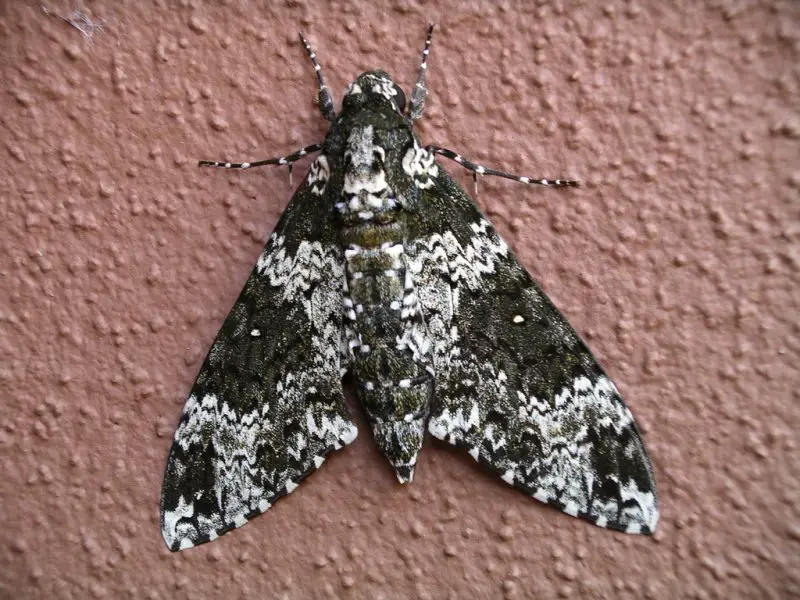
The Rustic Sphinx is a robust moth with mottled gray and brown wings and a wingspan of about 4.5 to 5 inches. Its body is marked with striking white spots along the abdomen, giving it a somewhat patterned appearance compared to the plainer Five-spotted Hawkmoth.
Caterpillars feed on plants in the nightshade family, including jasmine, honeysuckle, and fringe trees. They are typically green with diagonal stripes along their sides, and like many hawkmoth caterpillars, they possess a tail horn.
In Colorado, this moth is less common than the White-lined or Five-spotted Sphinx but can still be found in warmer areas during summer. Adults are primarily nocturnal and come to light sources, though they may also be observed feeding on nectar from large flowers at dusk.
Blinded Sphinx (Paonias excaecata)
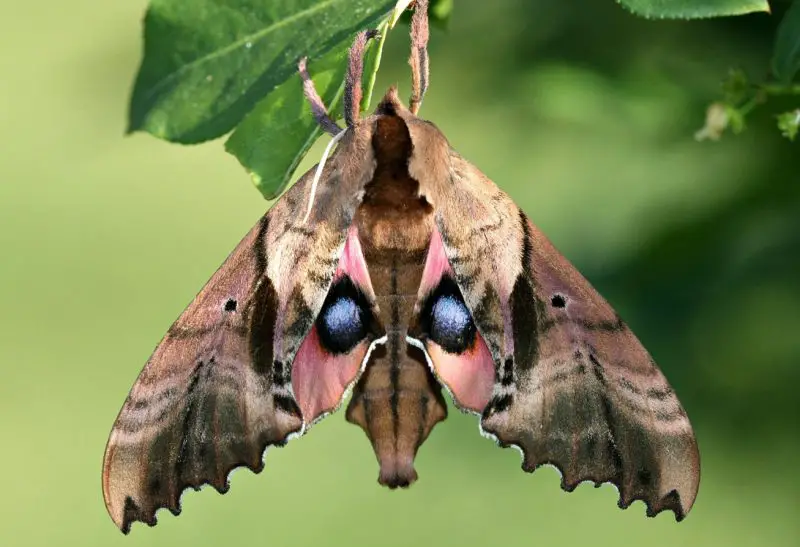
The Blinded Sphinx is a medium-sized moth with a wingspan of 2.5 to 3.5 inches. Its forewings are gray-brown with scalloped patterns, giving it excellent camouflage against bark. When disturbed, it flashes its hindwings, which are pink with dark eyespots, to startle predators.
The name “Blinded” comes from the fact that its eyespots lack the central white spot seen in many other moth species. This defensive display is one of its most recognizable traits.
In Colorado, the Blinded Sphinx is found in woodlands, gardens, and areas with hardwood trees such as birch, cherry, and plum. Adults are nocturnal and often come to lights, while caterpillars feed on the foliage of these host plants.
Small-eyed Sphinx (Paonias myops)

The Small-eyed Sphinx is similar in appearance to the Blinded Sphinx but slightly smaller, with a wingspan of 2 to 3 inches. Its forewings are patterned in shades of brown and gray, while its hindwings display pink with a small eyespot—much less dramatic than its relative.
Caterpillars feed on cherry, apple, hawthorn, and plum trees, making them common in orchards and residential areas. They are green with diagonal stripes and a tail horn, blending in well with foliage.
In Colorado, the Small-eyed Sphinx is active during summer nights and is attracted to artificial lights. It is less commonly seen than the White-lined or Five-spotted Sphinx but is still widespread wherever fruiting trees are present.
Polyphemus Moth (Antheraea polyphemus)
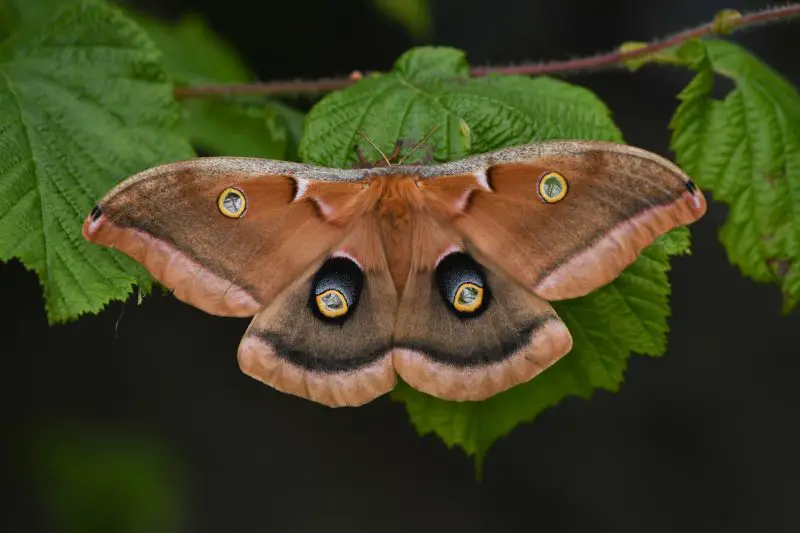
The Polyphemus Moth is one of the largest silk moths in Colorado, with an impressive wingspan of 4 to 6 inches. Its wings are light brown with subtle lines, but the most striking feature is the large eyespots on the hindwings. These eyespots resemble the gaze of an owl and serve as a defense against predators.
Caterpillars are bright green with small silvery spots along their sides. They feed on a wide range of trees, including oak, maple, willow, and birch, making them adaptable across different habitats.
In Colorado, adults are active from late spring to midsummer. They are nocturnal and strongly attracted to lights. Unlike many moths, adults do not feed, relying entirely on stored energy reserves, and live only about a week to reproduce.
Luna Moth (Actias luna)
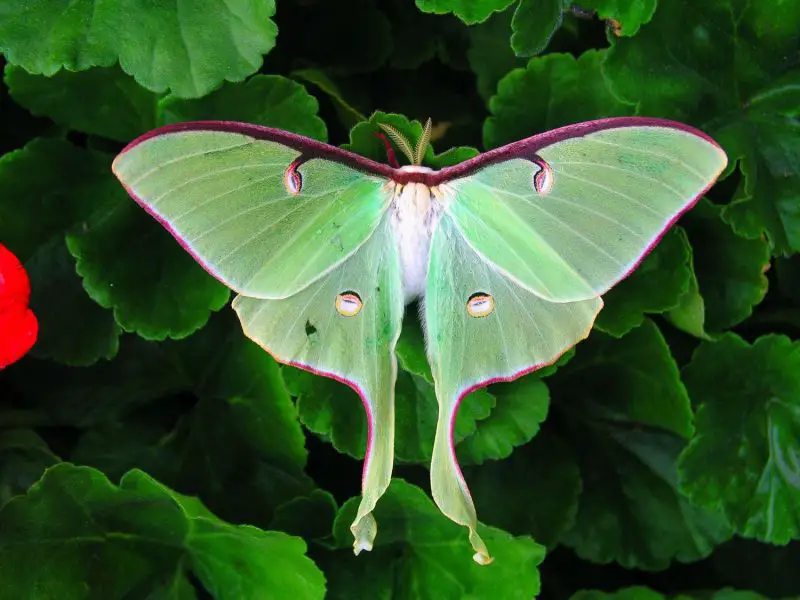
The Luna Moth is one of the most iconic moths in North America, admired for its pale green wings and long, curving tails on the hindwings. With a wingspan of 3 to 4.5 inches, it is both delicate and striking. Each wing bears a small transparent eyespot that helps distract predators.
The caterpillars are bright green with ridged segments and feed on a wide variety of hardwood trees such as birch, walnut, and hickory. Despite their size, they are often overlooked because of their excellent camouflage.
In Colorado, Luna Moths are less common than in eastern states but can be found in forested regions and areas with suitable host trees. Adults fly at night and are occasionally seen at porch lights, though spotting one is considered a special experience.
Cecropia Moth (Hyalophora cecropia)
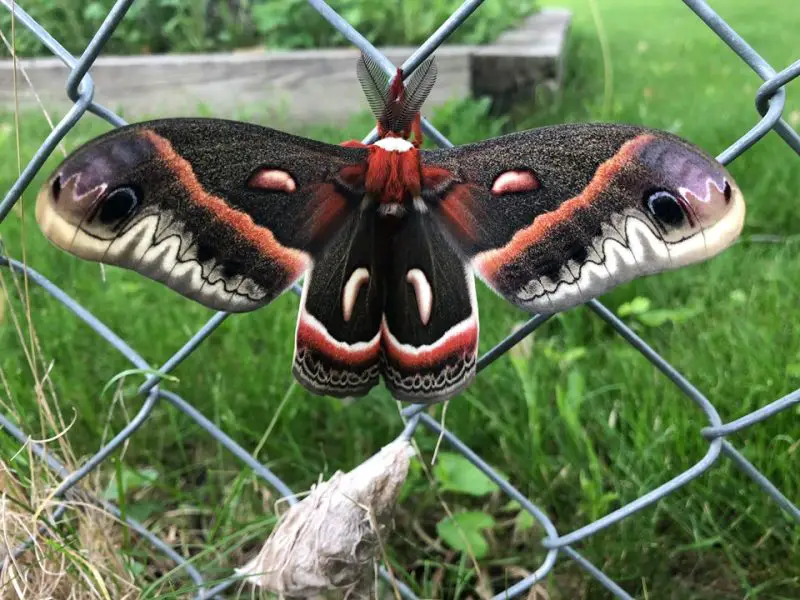
The Cecropia Moth is North America’s largest native moth, with wingspans reaching up to 7 inches. Its wings are brown with bands of white, red, and tan, along with crescent-shaped marks that make it unmistakable. The furry red body and large antennae add to its striking appearance.
The caterpillars are equally impressive—bright green with colorful knobs of blue, yellow, and orange. They feed on a wide variety of trees and shrubs, including maple, birch, cherry, and willow.
In Colorado, Cecropia Moths are rare but can be encountered in wooded areas and suburbs with host trees. Like other giant silk moths, adults do not eat and live only for a short time, focusing solely on reproduction.
Io Moth (Automeris io)
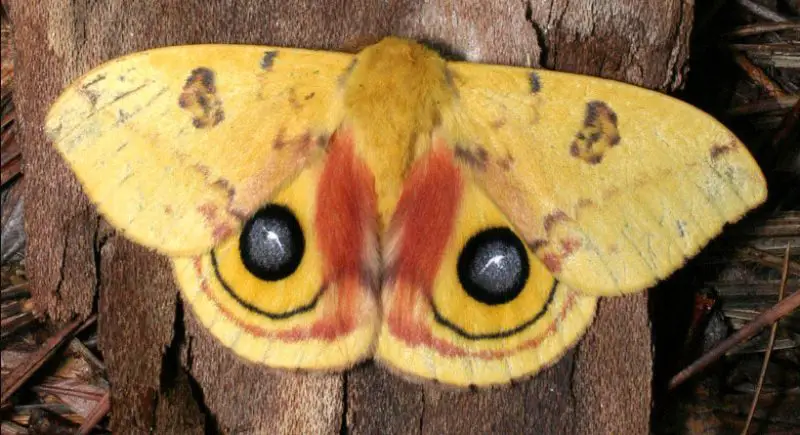
The Io Moth is a medium-sized silk moth, with males usually yellow and females brown, both featuring striking hindwings with large black and blue eyespots. These eyespots are hidden at rest but displayed suddenly when the moth feels threatened, startling predators.
The caterpillars are bright green with rows of branched stinging spines that can deliver a painful sting to humans. They feed on a variety of plants, including willow, hackberry, and clover, making them fairly adaptable.
In Colorado, the Io Moth is found in warmer habitats, particularly along woodland edges and meadows. Adults fly at night, and while not as common as other moths, they are sometimes drawn to lights in summer.
Isabella Tiger Moth (Pyrrharctia isabella)
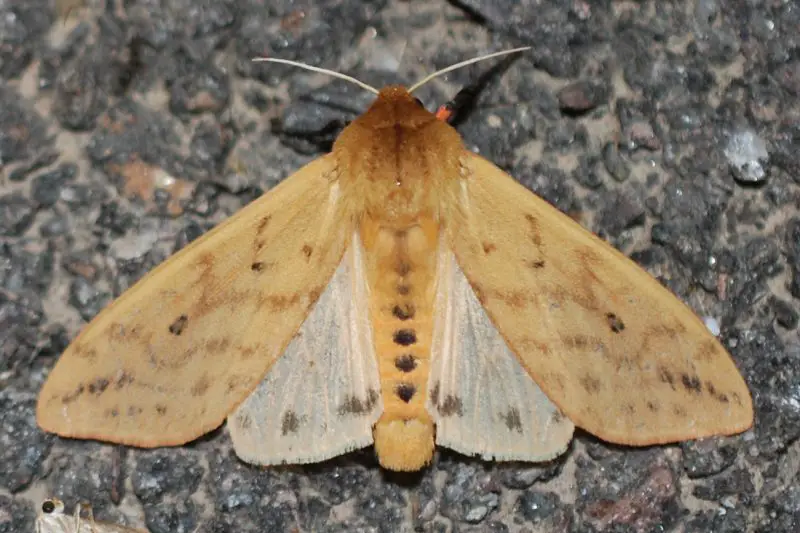
The Isabella Tiger Moth is best known in its larval form as the Woolly Bear caterpillar, a fuzzy black and orange-banded caterpillar often seen crossing roads in autumn. The adult moth is much less striking, with a wingspan of about 1.5 to 2 inches and dull orange-brown wings with small black spots.
Caterpillars feed on a wide variety of low-growing plants such as grasses, clover, and dandelions, which makes them very common. They overwinter as larvae, surviving freezing conditions, and then pupate in spring to emerge as adults.
In Colorado, Woolly Bears are familiar sights in fall, while adults fly in late spring and summer. Though plain compared to their caterpillars, the Isabella Tiger Moth is widespread and well-adapted to both urban and rural habitats.
Virginian Tiger Moth (Spilosoma virginica)
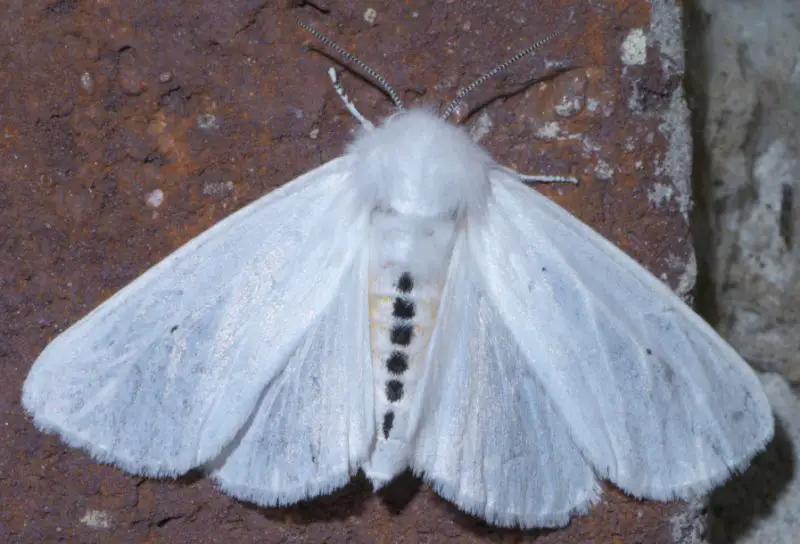
The Virginian Tiger Moth is a delicate white moth with a wingspan of 1.5 to 2 inches. Its forewings are pure white with small black dots, while the hindwings can sometimes show a faint yellow or pinkish tint. The moth has feathery antennae and a furry white body, which adds to its soft appearance.
Caterpillars of this species are known as “yellow woolly bears.” They are covered with long hairs that vary from cream to yellow or even orange. These caterpillars feed on a wide variety of plants, including dandelions, clover, and other common weeds.
In Colorado, the Virginian Tiger Moth is widespread in gardens, fields, and open meadows. Adults are nocturnal and attracted to lights, making them one of the more frequently seen white moths during summer nights.
Clymene Moth (Haploa clymene)
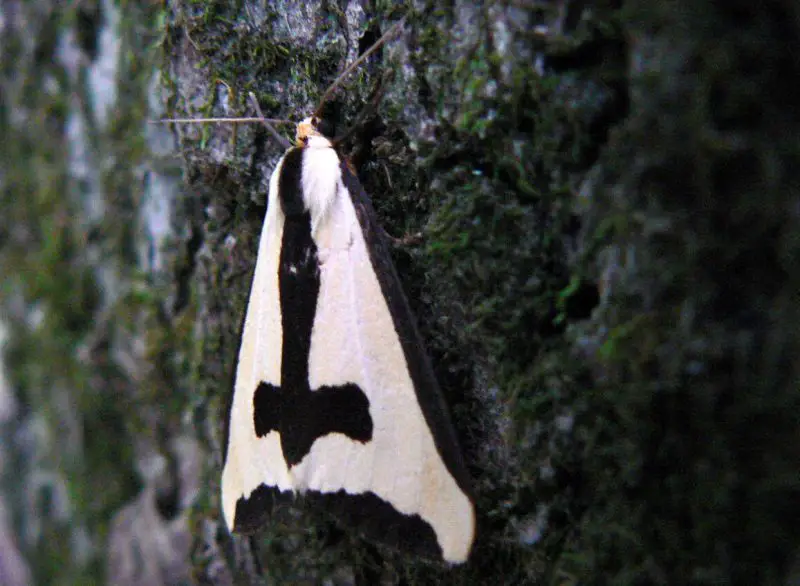
The Clymene Moth is striking in appearance, with creamy white forewings crossed by bold black lines that form a cross-like pattern. Its hindwings are bright orange with a large black patch, which is revealed when it flies. The wingspan usually measures between 1.5 and 2 inches.
Caterpillars are dark with small spines and feed on a variety of host plants, including oak, willow, and peach. They are hardy feeders and can be found in woodland areas and gardens alike.
In Colorado, the Clymene Moth is not as common as in the eastern United States, but it can be found in forested areas and open fields during summer. Its bold wing markings make it easier to identify compared to other moths in the same family.
Yellow-collared Scape Moth (Cisseps fulvicollis)
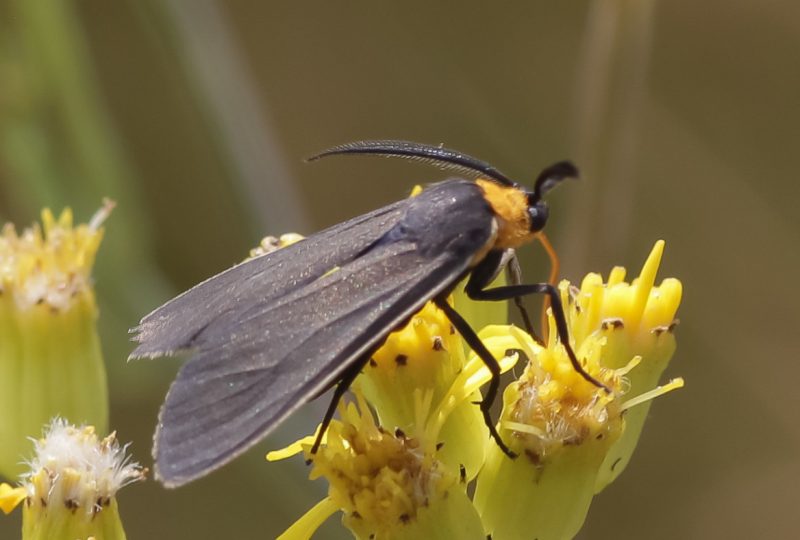
The Yellow-collared Scape Moth is often mistaken for a small wasp because of its slender body and dark wings. Its most distinctive feature is the bright orange-yellow “collar” around the head. The wings are dark bluish-black and narrow, while the body is shiny and elongated. The wingspan ranges from 1 to 1.5 inches.
Caterpillars feed on grasses and low-growing plants, while adults are often seen flying during the day, feeding on nectar from goldenrods, milkweeds, and asters. Their day-flying behavior adds to the confusion with wasps.
In Colorado, this moth is common in meadows, grasslands, and gardens. It is active during late summer and early fall, especially where wildflowers bloom.
Ailanthus Webworm Moth (Atteva aurea)
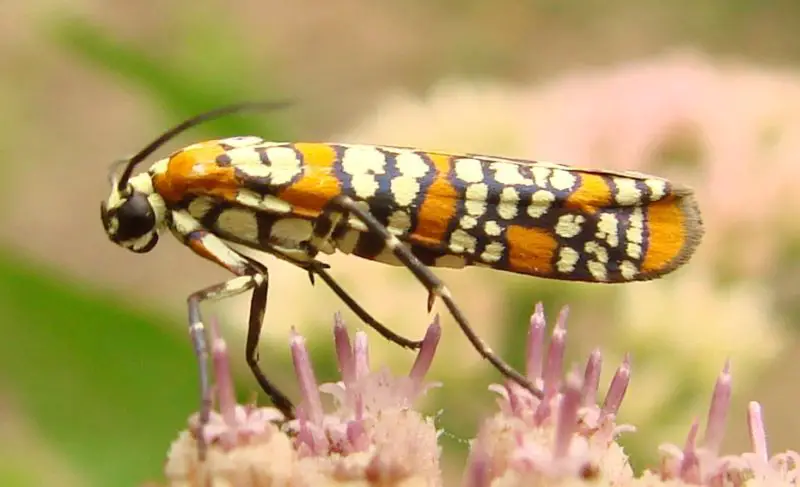
The Ailanthus Webworm Moth is a small but colorful species with a wingspan of only about 1 inch. Its forewings are orange with white spots outlined in black, giving it a jewel-like appearance. When at rest, it folds its wings tightly against its body, resembling a narrow cylinder.
The caterpillars feed on the invasive tree-of-heaven (Ailanthus altissima), which is where the moth gets its name. They create communal webs on the host tree, feeding together and spinning silk shelters.
In Colorado, the Ailanthus Webworm Moth is often found in urban areas, especially where ornamental or wild tree-of-heaven plants grow. Adults are active both during the day and night and are commonly seen visiting flowers in late summer.
Salt Marsh Moth (Estigmene acrea)
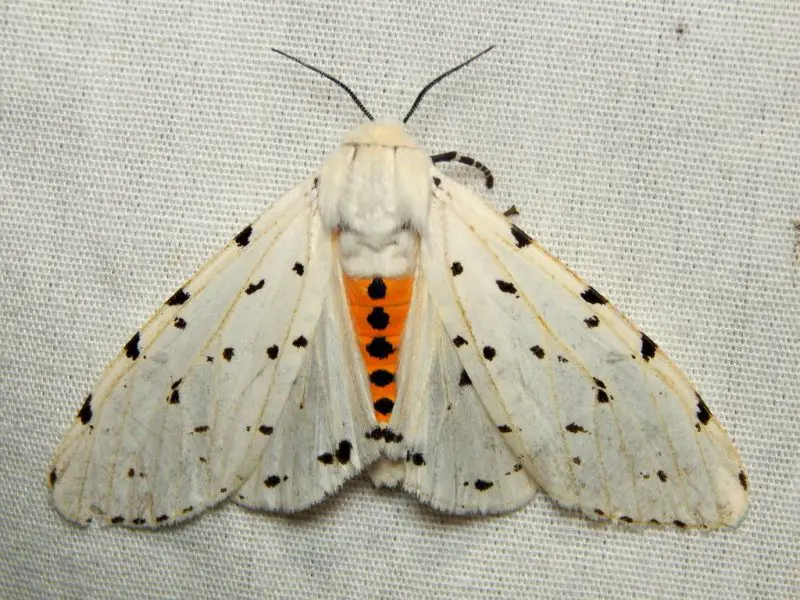
The Salt Marsh Moth is a medium-sized moth with a wingspan of 1.5 to 2 inches. Adults have white wings with scattered black spots, and their hindwings can be yellow or orange with additional black markings. The thorax is covered in white “fur,” making them look quite fluffy.
Caterpillars, often called “woolly bears,” are dark brown to black and covered with dense bristles. They are generalist feeders, eating a wide range of plants, including dandelion, clover, and garden crops.
In Colorado, the Salt Marsh Moth is common in fields, meadows, and gardens. Adults fly at night and are attracted to lights, while caterpillars are often seen feeding in open habitats during late summer.
Best Time and Place to See Moths in Colorado
The best time to see moths in Colorado is during the warm months, from late spring through early fall. Most species are nocturnal, so evenings and nights are the most active times, especially around porch lights, street lamps, and light traps. Some species, like the Hummingbird Clearwing Moth and Yellow-collared Scape Moth, are day-flying and can be spotted visiting flowers under bright sunlight.
In terms of locations, moths can be found across Colorado’s diverse landscapes. Gardens, meadows, and urban areas are excellent for spotting species like the White-lined Sphinx or the Army Cutworm. Forest edges, riparian zones, and mountain foothills provide habitat for larger silk moths such as the Polyphemus and Cecropia Moths. Even agricultural fields and vineyards attract species like the Achemon Sphinx and Pandora Sphinx.
The Rocky Mountains also play a unique role, especially during Miller Moth migrations, when millions of moths move from the plains to higher elevations. This makes mountain towns and alpine meadows some of the most dramatic places to witness moth activity in summer.
FAQs about Moths in Colorado
What is the most common moth in Colorado?
The White-lined Sphinx Moth and the Army Cutworm (Miller Moth) are among the most common moths in Colorado. Miller Moths are especially well-known because they migrate in huge numbers and often enter homes, while White-lined Sphinx Moths are frequently seen hovering around flowers.
Why are there so many Miller Moths in Colorado?
Miller Moths are the adult form of the Army Cutworm. In late spring, they migrate from the eastern plains of Colorado to the Rocky Mountains, seeking cooler conditions and flower nectar. This migration can bring massive numbers of moths into cities, where they are attracted to lights and sheltered spaces.
Do moths in Colorado bite or sting?
No, moths do not bite or sting. Most adult moths feed only on nectar, and some, like the silk moths, do not feed at all. However, certain caterpillars, such as the Io Moth caterpillar, have stinging hairs that can irritate the skin if touched.
Are moths beneficial in Colorado?
Yes, moths play important ecological roles. Many are pollinators, visiting flowers at night when bees are inactive. Moth caterpillars also serve as a major food source for birds, bats, and other wildlife. Even Miller Moths provide a crucial fat-rich food supply for bears in the Rocky Mountains.
Can I attract moths to my garden in Colorado?
Yes, planting nectar-rich flowers like evening primrose, honeysuckle, and phlox will attract moths at night. Turning on outdoor lights also brings moths into view, though this can sometimes disrupt their natural behavior. For a more natural experience, consider using a low-intensity UV moth light trap in your yard.

